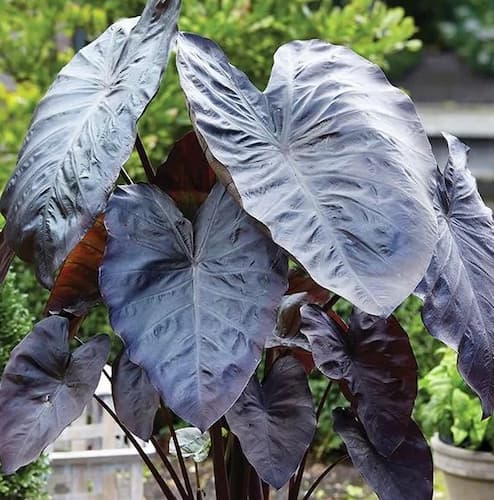How to Grow Elephant Ears

About Growing Elephant Ears Plant in Your Home Flower Garden
Elephant Ear plants are a big, leafy member of the Caladium family. We’re talkin’ big leaves, as big as an elephant’s ear. The colorful leaves have a shape resembling an elephant’s ear, too. Homeowners and all who see this plant are fascinated by the attractive and huge leaves. Along with big leaves, elephant ear bulbs are huge, too. They are 8-11 inches in circumference. Originating in tropical and sub-tropical areas, they love sunshine, heat, and high humidity. So, are you ready to grow it? We sure hope so. You will find growing Elephant Ears is rather easy. And, it grows in both sun and shade.
They are well suited as a background plant, or to separate areas of your garden. Also, it is often a landscape focal point, with other flowers strategically planted around them. Try growing them on your patio or deck. But, be sure to put them into a very large container. As they grow, they can offer a little shade from the hot summer sun.
Note: This plant is poisonous to children and pets.
Flowers Bloom: While this plant is grown for its huge, attractive foliage, it does produce flowers in the late Spring to Summer.
Flower Colors: Yellowish-white
Native to: Asia, Australia, Central and South America, and Africa.
Plant height: Depending upon variety, plants grow 12 to 15 feet tall and 6 to 8 feet wide.
Plant Hardiness Zones: This tropical perennial grows in zones 8 – 11. It does not like cold weather.
Elephant Trivia: Elephants can distinguish different languages. And, they can hear or sense sounds through their feet.
Elephant Ears Plant Plant Propagation
Elephant Ears are grown from tuberous bulbs. After the plants have died back in the fall, dig up the elephant ear bulbs. Clean and store them in a cool, dark area until planting the following spring.
In the spring, replant Elephant Ear bulbs into your garden after the risk of frost has passed. For an early start, plant them in containers indoors six to eight weeks before the last frost date. After planting your Elephant Ears, have patience. It may take several weeks for the plant to first emerge. Once it sprouts, a growing Elephant ear plant can grow at a fast pace.
In southern areas, they can remain in the ground over winter. Add a heavy layer of mulch to protect the bulbs from freezing.
Planting Depth: Plant bulbs 2 to 3 inches deep with the blunt end down.
Final Plant Spacing: Depending upon variety, the final spacing should be 6 to 8 feet apart. Don’t crowd this attractive plant.
How to Grow Elephant Ears Plant
You’ll enjoy growing this plant. They are low maintenance and require little attention. As result, you can enjoy more of the great summer weather. Plant the bulbs in the spring. Find a sunny location, as these plants like hot sun and humidity. They grow best with six or more hours of direct sunlight. Elephant ears prefer rich, organic soil. They are moisture lovers, yet the soil needs to drain well.
Note: Elephant Ear plants can be invasive. So, you may want to install a border edging 3″-6″ deep into the soil around the plants.
While elephants like peanuts, you’ll need more than that to fuel the fast and vigorous growth of your elephant ears plant. Mix in plenty of compost and organic matter at the planting site. Then, apply a nitrogen-rich fertilizer once a month for optimum growth. Try slow-release formulas high in nitrogen. Keep the soil moist all season long. Occasional, short-term wet soils should not be a problem.
Mulch around plants heavily every year to help retain water, and replenish organic matter.
In the fall, dig up the bulbs for storage. Allow them to dry for 2-3 days. Then, place them in moist peat moss or sphagnum moss. Store the container in a cool, dark place. Basements usually work well. Or, store them in your garage only if the low temperature doesn’t go below freezing. The bulbs will survive over-wintering outdoors only in the warmest areas of the country.
Ideal Soil pH: 6.0 – 7.5.
Insects and Plant Disease
Occasional problems with burrowing insects can occur. Spider mites can also be a problem. Use insecticides or organic repellents as needed.
Fungal leaf blight, bacterial leaf spots, and leaf scorch can be a problem. Use fungicides only as needed. Leaf scorch is most common in very hot areas. Try to provide shade from hot, midday sunlight.
On the Light Side

Here is a special holiday we know you will love:
Related Articles
Also, people who read this article will like:
Flower Gallery Find pictures of your favorite flowers.
Buy Bulbs and Plants – Enjoy this unique plant.
Please support our site. Shop for:
- rmmatthews100@hotmail.com
- 585-721-6528
- Rochester, NY
©1999-2024 GardenersNet.Com, All Rights Reserved

